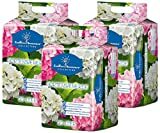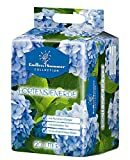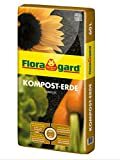The beautiful hydrangea blossoms only develop with optimal care. We show everything you need to know about watering, pruning and fertilizing hydrangeas correctly.

hydrangeas (Hydrangea) can be a real beauty in the garden. But sometimes it's not so easy to achieve the lush flowering you want every year. You have to deal with the care of the flowers a little to avoid flowering failures or yellow leaves on the hydrangeas to avoid. If you follow our expert tips, you will no longer have to worry about such failures.
contents
- watering hydrangeas
- Fertilize hydrangeas
- pruning hydrangeas
- Hydrangeas overwinter
- support hydrangeas
-
Pests and Diseases of Hydrangeas
- Yellow leaves on hydrangeas: iron deficiency
- Mealybugs on hydrangeas
Hydrangeas are reliable flowering classics in the garden - but only with the right care. From watering and fertilizing to supporting the large inflorescences of hydrangeas - here you will learn everything about the correct handling of the beautiful divas.
watering hydrangeas
Hydrangeas are very thirsty. regular watering the hydrangeas is therefore essential, especially for specimens in planters. But hydrangeas that have been planted in the bed are also happy about an occasional watering. A lack of water is quickly noticeable in hydrangeas: sagging leaves and flowers are a first sign. Before that, you can also observe that the color of the foliage changes to a much darker green.
Instructions for watering hydrangeas:
- Check the soil/substrate regularly, when it starts to dry out it is time for watering
- It is best to water with rainwater, tap water is often alkaline and raises the pH value in the soil
- Don't water everything at once like a monsoon, but rather distribute the watering over several small doses
- Avoid waterlogging, so provide buckets with drainage holes
- Potted hydrangeas may need to be watered several times a day in summer, preferably in the morning or evening
- In winter, the hydrangea does not need to be watered

Fertilize hydrangeas
Hydrangeas should be fertilized organically or organo-mineral. one in mineral fertilization is possible, but harms the plant in the long term by deteriorating the soil quality. It also makes micronutrient deficiencies more likely to occur.
Instructions for fertilizing hydrangeas:
- One organic fertilizer application for planting should be distributed evenly in the planting hole and poured in well.
- Hydrangeas in the field are sufficient organic or organic-mineral fertilization per year, which should be strictly between March and May. Later fertilization can endanger the flowering of the following year and, if too much nitrogen is given, can also affect the entire plant through frost damage.
- Potted hydrangeas are fertilized twice a year because of the smaller substrate volume: they receive two thirds of the fertilizer application between March and May, the last third between June and August. Especially on the second date, the use of organic, potassium-rich fertilizers is important. Nitrogen is released by these rather as needed and does not lead to the formation of new shoots that are susceptible to frost. The potassium increases frost tolerance, it serves as a kind of antifreeze in the vacuoles of the cells.
When supplying nutrients to hydrangeas, the pH value of the soil must always be taken into account. The richly flowering beauties do much better in acidic soil than in neutral or slightly alkaline soil. A pH value of around 4.5 is required for the formation of blue flowers. Also the fairly common one Iron deficiency of hydrangeas depends on the acidity of the soil: if this is not sufficiently acidic, iron is poorly available for hydrangeas. Consider this when planting and use, for example, rhododendron soil, oak leaves or coniferous soil to keep the soil acidic.
Our Plantura organic hydrangea fertilizer is organo-mineral and protects your beloved hydrangeas from frost damage with a potassium-rich nutrient composition. The smooth implementation promotes even growth and flowering. To prevent iron deficiency, this trace nutrient element is also included, so that even small pot volumes do not run out of it.
Accurate information on Fertilization of hydrangeas as well as dosing instructions can be found here in our special article.
pruning hydrangeas
The right cut is essential for magnificent flowers. Hydrangeas can be pruned in either fall or spring. In order to determine the right time, one should first know which hydrangea species it is. Then peasant hydrangeas (Hydrangea macrophylla) and Oakleaf Hydrangeas (Hydrangea quercifolia) develop their flowers for the following year already in autumn. So they bloom on the previous year's wood. If you cut back too much here, it can mean the loss of the beautiful flowers. panicle hydrangeas (Hydrangea paniculata) or viburnum hydrangeas (Hydrangea arborescents), on the other hand, bloom on so-called one-year-old wood. That is, they form their flowers in the same year that they flower. So these two popular hydrangeas are among the species that can be pruned back without hesitation.
More information and a guide to Cutting hydrangeas can be found in this special article.

Hydrangeas overwinter
As a rule, one can rely on the fact that all offered in Germany Hydrangea Species are reasonably hardy. In this case, reasonably means that frost damage is unfortunately quite possible and can also affect the flowering. To avoid this, you should note the following:
- When planting, a sheltered spot in semi-shade should be chosen.
- A winter protection made of leaves, a jute bag, fir branches or mulch protects the plant. Above all, always cover the outer shoots that are close to the ground.
- Fertilizing with mineral nitrogen is taboo from mid-July. Organic fertilizers can be used well into August.
- The fertilizer used should have a sufficiently high potassium content, as this is essential for frost resistance.
- Even if the temperatures are rising, you should stay up until the end of the ice saints (11. to 15. May) do not completely remove the winter protection yet. Have the jute sack ready for frosty nights. Of course, it is possible and important to expose the plant in the first warm weeks.
- Potted hydrangeas are protected in the same way as their outdoor relatives. In addition, they should spend the winter in sheltered garden areas. Containers with a diameter of less than 35 centimeters are best overwintered in a shed or garage in a frost-free place (3 - 5 °C).
More information about Overwintering hydrangeas can be found in the corresponding special article.

Tip: When buying hydrangeas, pay attention to the condition they are in. Some garden centers still offer fall-blooming plants that are propelled in the greenhouse. Overwintering them outdoors inevitably leads to severe frost damage, because in order to produce attractive plants, they are often fertilized far too abundantly during cultivation. Tree nurseries often offer somewhat more expensive, but higher-quality goods and better advice.
support hydrangeas
Especially snowball hydrangeas (Hydrangea arborescents) due to their growth and the large inflorescences tend to lean towards the ground due to the excessive load at flowering. But also the classic peasant hydrangea (Hydrangea macrophylla) sometimes hangs its head, although it does not lack water - especially if it is in too shady locations and the shoots tend to be long and unstable.
Of course, hydrangeas look all the more impressive when they stand upright and stretch their splendor towards the sky. There are two ways to help hydrangeas that tend to droop to an upright existence:
- Support hydrangeas with bamboo sticks
- Support hydrangeas with perennial rings or perennial supports

You can support the individual shoots of the hydrangea with a bamboo stick. This helps to provide more stability, but also looks ugly very quickly. A good alternative to the bamboo sticks are perennial rings or perennial holders available in specialist shops. The circular perennial rings with a fastening rod in the middle can be used to stabilize smaller hydrangea specimens. Larger plants are better supported and kept in an upright position with the semi-circular perennial supports.
Pests and Diseases of Hydrangeas
With good care, hydrangeas are usually not particularly susceptible to diseases and pests. If your hydrangea is nevertheless affected, we will show you below what you can do against yellow leaves and mealybugs on hydrangeas.
Yellow leaves on hydrangeas: iron deficiency
If your hydrangea's leaves are turning yellow, the cause may be an iron deficiency, also known as chlorosis. Such chlorosis is often found in hydrangeas in particular. This is usually caused by a nutrient deficiency. The missing nutrient in hydrangeas is almost exclusively iron, although there is almost always enough of it in the natural soil. The reason for the deficiency is therefore not a lack of iron in the soil, but that the hydrangea cannot absorb the iron that is present. This occurs in hydrangeas when the pH is too high. The moor bed plant is adapted to low pH values of around 4 - 5.5. In order for the pH value to be determined correctly, a pH test is necessary. If the measured pH value is too high, it can be lowered with rhododendron earth, lime-free peat or Epsom salt. It is best to plant hydrangeas in tubs in pure rhododendron soil, then you do not have to worry about chlorosis.
More information about Iron deficiency in hydrangeas see this article.
Mealybugs on hydrangeas
Mealybug (pseudococcidae) are also often called mealybugs and particularly like to sit on our hydrangeas. They are very easy to spot as they are surrounded by a white web that resembles tiny white hairs or lint. Mealybugs attach themselves to the plants and then ingest the plant sap, which can transmit harmful viruses to the plants. They also excrete the sticky honeydew on which fungi often grow. Therefore, it is not uncommon for sticky spots to be discovered on the plants, which often turn dark or black due to the fungi. As the lice suck on the hydrangeas, the infested leaves turn yellow and eventually fall off. If the infestation with mealybugs is very severe, the hydrangeas can even die.
As Mealybugs on hydrangeas You can find out how to fight them successfully here.
We at Plantura recommend the following products for hydrangeas:- Floragard Endless Summer hydrangea soil pink & white: Special soil for healthy and strong hydrangeas. The clay granules improve air and water circulation.
- Floragard Endless Summer hydrangea soil blue: Special soil for healthy and strong hydrangeas. Aluminum fertilizer keeps the strong, bright blue blooms in the long term. The clay granules improve air and water circulation.
- Floragard compost soil: Special soil made from weed-free premium compost and selected peat qualities. It supplies your plants with all the important nutrients over a long period of time and evenly, and the high humus content makes light and heavy soil fertile.

Floragard Endless Summer hydrangea soil pink/white 3x20 L • for planting and...
25,99€
Details →

Floragard Endless Summer hydrangea soil blue 20 L
7,99€
Details →

Floragard compost soil 60 L
9,99€
Details →
